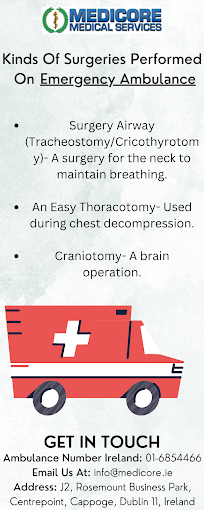The Future of Emergency Ambulance Services: Innovations and Advancements
Emergency ambulance services play a critical role in saving lives every day, and with advancements in technology, the future of these services is becoming more exciting than ever. The medical field is constantly evolving, and the ambulance industry is no exception.
Here, we explore the latest innovations and advancements that are shaping the future of emergency ambulance services.
Advanced Medical Equipment and Techniques
One of the most exciting developments in emergency ambulance services is the introduction of advanced medical equipment and techniques. For example, ambulances are now equipped with cutting-edge devices such as portable defibrillators, oxygen delivery systems, and advanced life support systems. Additionally, ambulance crews are trained in new techniques, such as advanced airway management and needle decompression, which can greatly improve patient outcomes.
One of the most exciting developments in emergency ambulance services is the introduction of advanced medical equipment and techniques. For example, ambulances are now equipped with cutting-edge devices such as portable defibrillators, oxygen delivery systems, and advanced life support systems. Additionally, ambulance crews are trained in new techniques, such as advanced airway management and needle decompression, which can greatly improve patient outcomes.
Telemedicine and Remote Monitoring
Telemedicine and remote monitoring technologies are also transforming the ambulance industry. In the future, it will be possible for ambulance crews to consult with doctors and specialists in real time, giving them access to expert advice and guidance during emergencies. This will enable them to provide more effective and efficient care, as well as to make faster, more informed decisions.
Telemedicine and remote monitoring technologies are also transforming the ambulance industry. In the future, it will be possible for ambulance crews to consult with doctors and specialists in real time, giving them access to expert advice and guidance during emergencies. This will enable them to provide more effective and efficient care, as well as to make faster, more informed decisions.
Increased Automation
Another exciting development in the ambulance industry is the increased use of automation. Ambulances are equipped with automated systems that can perform tasks such as monitoring vital signs, administering medication, and even driving the vehicle. This not only makes the ambulance crew's job easier, but it also ensures that patients receive prompt and consistent care, no matter who is on duty.
Another exciting development in the ambulance industry is the increased use of automation. Ambulances are equipped with automated systems that can perform tasks such as monitoring vital signs, administering medication, and even driving the vehicle. This not only makes the ambulance crew's job easier, but it also ensures that patients receive prompt and consistent care, no matter who is on duty.
Improved Response Times
Finally, the future of emergency ambulance services will be characterized by improved response times. With the use of GPS and real-time traffic data, ambulances will be able to reach patients more quickly and efficiently, even in the most challenging conditions. This will be particularly important in rural and remote areas, where access to emergency medical services can be limited.
Finally, the future of emergency ambulance services will be characterized by improved response times. With the use of GPS and real-time traffic data, ambulances will be able to reach patients more quickly and efficiently, even in the most challenging conditions. This will be particularly important in rural and remote areas, where access to emergency medical services can be limited.
In conclusion, the future of emergency ambulance services is looking brighter than ever, with exciting new innovations and advancements that are set to transform the way we provide medical care. Whether it's through the use of advanced medical equipment, telemedicine, automation, or improved response times, these developments are making emergency ambulance services more effective and efficient than ever before.




Comments
Post a Comment